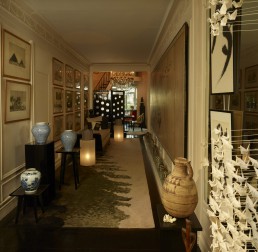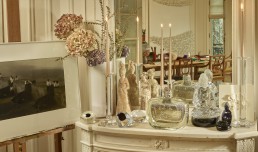Japanese by origin, Parisian by choice, the late fashion designer created a world full of color for an everyday wardrobe and an impeccable taste expressed through interior design.
Kenzo Takada’s legacy remains, undoubtedly, as fresh as it was back in the day. He was the first Japanese designer to show in Paris in 1970 and splashed the establishment with textures, folklore, and volumes for an uncomplicated, light and casual way of life. He arrived to Paris five years earlier.
With his creations made with fabrics suitable for kimono making, he created an intimate language of using Japanese materials with an unexpected and unusual treatment for the time. Born in Himeji in post-war Japan, Takada entered the fashion world as one of the first male students in the prestigious Bunka Gauken College in Tokyo in 1958, a brave thing to do.
Working as a freelance illustrator in Paris the ‘capital of fashion’, he sold drawings to houses like Louis Féraud and ELLE Magazine -the covers came later- to stay ahead. But his journey really started when, knowing he could not compete with famous couturiers and big budgets of the time, he simply dared to be different, innovating and creating something really unseen.
In a modest corner on Galerie Vivienne, Jungle Jap was born, a modern fashion space, combining a boutique clothing offering with artistic happenings that changed, forever, the way a fashion store should be. In this context, Takada was creating the foundations of the contemporary ‘concept store’ as we know it today.
The mythical store interiors were inspired by the canvas ‘Le Rêve’ of Henri- le douanier- Rousseau, a fantasy jungle decor, exposed today in MoMA. With a special attention for colors, details, flowers and motifs, Kenzo understood all youth expectations, creating fashion’s according to the zeitgeist and establishing a very powerful visual trademark.
The Foundations of a Worldwide Aesthetic
One of the most significant of Kenzo’s contributions to fashion was a cultural miscegenation approach, honoring his Japanese heritage and world’s folklore, with a playful yet colorful-mix and match inspirations.
He conceived volume as a form of freedom for the body against flat cuts. His eclectic vision and imagination were exposed through all of his work. With Moroccans Djellaba, Indian robes and saris, the Mao style from China, Vietnamese jackets and trousers and long and wide Slavic skirts.
In a way, he was re-introducing orientalism brought by Paul Poiret in the early XX century. He was too a devotee of color, textures, prints, exotic fabrics, and the joy of living.

©Pearl Metalia – Thomas Hennocque
“In my collections, it is spring all the year”
Interior Design and Fashion: A Life Through Objects
After stepping down from fashion in 1999 -LVMH acquired his brand in 1993-, he started a vast collection of objects and traveled; to have the essence of the world inside his Paris home over the last fifteen years of his life.
A year ago, he was launching K三 a luxury home and lifestyle brand, an interior design venture founded by him and partners Jonathan Bouchet Manheim, Engelbert Honorat, with the expertise of creative designer and interior designer Wanda Jelmini of T&J Vestor and Missoni Home.
His approach to interior design was an experience, a classic style and the use of noble materials. K三 is an extensive yet meticulously curated collection of chairs, sofas, tables, rugs, home textiles and accessories, a colorful ode to life with great craftsmanship blending a modern twist. The meaning of the name K三 has its roots in the Japanese kanji.”三”, which means the number “three”, as well as balance and harmony.
His multicultural brand identity combined with the foundational goal of inspiring cheerfulness, joy and poesy using bright colors, bold patterns, and an audacious lust for life.

©Pearl Metalia – Thomas Hennocque
“For me to create is to give pleasure and happiness to others, and the freedom to be myself”
An Exuberant Collection to Auction

©Pearl Metalia – Thomas Hennocque
In the heart of Saint Germain quarter, in a light-filled Haussmann style apartment re-designed by his friend the architect Ed Tuttle, lays his ultimate collection of more than 600 items including Art Deco furniture, paintings, objects, crystal chandeliers and works of art (Asian, Pre-Columbian, and Tribal), with influences of the East and West, reflecting an exuberant and personal gaze on interior design.
Artcurial will pay a final tribute to the multi-talented artist, with a special auction in May 2021. “The collection reveals the eye of this genius in the world of fashion and interiors, he knew how to bring different cultures together”, comments the auctioneer Stéphane Aubert, regarding a large wooden Hinoki horse from the Han period, a Buddha torso dating from the 3rd century, a Pleyel grand piano by Ruhlmann and thirteen photographs by William Eggleston, among other remarkable pieces.
Tableware and porcelain will be featured, as well a selection of Japanese stoneware, Murano glassware and a Harcourt crystal service by Baccarat marked with the designer’s emblem.
As Takada always stated, “everything starts with a drawing, Nehru, Botticelli, Rashômon by Kurosawa, Romania, Africa, China, Mickey Mouse. It can all be a source of inspiration”
A brilliant man who dedicated his life to art, culture, fashion and interior design.
Do you want to learn more about this topic? Find more in the Interior Design program.
